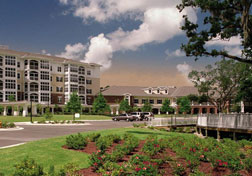 Cross Village at Notre Dame Unit sizes are doubling at Holy Cross Village at the University of Notre Dame.
|
Instead of finding the coming generation of seniors on the golf course or in rocking chairs on their front porches, there may be more of them on college and university campuses, attending classes, mentoring students and cheering at sporting events alongside their young classmates.
Experts predict a surge of new and "repositioned" or revamped university-affiliated retirement communities worldwide. Some developers, consultants, architects and construction firms already are specializing in this niche, partnering with schools to create communities that meet the intellectual and health needs of older adults and the financial and community-service needs of the colleges and universities.
University-affiliated retirement communities are not new. The oldest of them have been around for more than 20 years. But the current two or three dozen will grow to upward of 400, or 10% of the 4,000 colleges and universities in the U.S., in the next 20 years, predicts Andrew Carle, associate professor and director of the program in assisted living/senior housing administration at George Mason University, Fairfax, Va. "There are probably at least 100 universities that are at least looking at this, if not developing one," he says. Carle was one of dozens of speakers at the National Association of Home Builders' "Building for Boomers and Beyond" conference held last month in Denver and attended by over 800 people.
New generations of seniors, including the 78 million baby boomers who start turning 62 in January, don't seek traditional retirement but rather intellectual stimulation, the company of smart young people, and if they can, the privileges of attending classes, lectures and sporting events at a university. A majority of residents of nearly all university-affiliated retirement centers have some tie to the university they are near.
Residents of The Village at Penn State have a Penn State ID card that allows them access to the university's libraries and campus events, hard-to-procure football and basketball tickets, reduced rates on tennis courts and golf courses and they can take classes for free on a space-available basis, says Jill Lilly, Village director of marketing.
At The Village, the university provides interns to help run the health care facility, teach five to seven exercise classes a day and give a monthly musical concert. "We have a lot of intergenerational activities," says Lilly.
The schools benefit from a wider diversity of students, experienced guest lecturers, mentors for younger students and gifts and bequests from residents. Juniata College, Huntingdon, Penn., is putting together a request for proposals for developers for a 120-unit active-adult retirement community on land it will sell to the venture. Juniata President Tom Kepple hopes to break ground a year from now. He asked his faculty if they wanted these people in their classrooms and they all raised their hands. He says, "I think what makes this sellable is, we're talking about [adding] 200 educated people [in a town of 8,000]. That is a wonderful pot of human capital."
Universities don’t always leap to their figurative feet cheering the idea of a bunch of seniors on their campus. “I have a hard time convincing college presidents and CFOs primarily that this isn’t about retirement; this is about education – this is about stimulating and providing the ambience for older adults, says Leon Pastalan, principal of Collegiate Retirement Community Consultants, Ann Arbor, Mich.
Affiliations with schools vary from very loose to quite tightly knit, says Matthew Weaver, executive vice president of PRAXEIS, Jacksonville, Fla., developer and manager of several of these types of communities. They can include any or most elements of participation from the schools: endorsements, land, programming agreements, use of the school's name, research, campus privileges and discounts, courses onsite at the community and more. "Lifelong learning, fitness and wellness, with programming agreements with the various colleges, that's what makes these projects unique," he says.
Proximity to the campus is also an issue. Some university-based retirement communities are 15 or 20 miles from campus. Others are on university property. If possible, closer is better. “Proximity equals participation,” says Pastalan.
 Oak Hammock at the University of Florida Senior housing communities these days, such as Oak Hammock at the University of Florida, are resort-like.
|
Designers of senior housing of all types have a new challenge with the aging baby boomers due to pour into the 55-plus market in the next few years. Typically architects have been designing for the age 62-plus age group, even in the active adult market, with an average age of 75, says Ed Hord, principal of Hord Coplan Macht Inc., Baltimore, who specializes in senior housing. Spaces have been small, with a focus on services for frailty, he adds. The new market of baby boomers will need to address an entirely different set of preferences. Boomers, who overall are in denial about their own aging, focus on staying active mentally and physically and are picky about nearly everything. “We will need to address ‘ACE’ – activity convenience and entertainment,” he says, which is very different from the more staid lifestyle and often out-of-the-mainstream locations of current senior housing. The university-based retirement communities should tie in very well with boomers’ desired lifestyles as they age.
Oak Hammock at the University of Florida in Gainesville is a high-end retirement community of 400 people. It has very close ties with the university; 18 of UF's colleges have affiliations with Oak Hammock and the university sponsored its creation. Although it is less than four years old, it is planning an expansion of the number of residential units.
Residents of Oak Hammock enjoy a 22,000-sq-ft fitness center, which does not go to waste. “About 70%of our population is working out regularly,” claims Star Bradbury, Oak Hammock director of marketing.
Fitness centers are among the most highly ranked of desired amenities among prospective residents of any 55-plus community, says Margaret Wylde, president and CEO of Oxford, Miss.-based ProMatura LLC, a research firm that specializes in the senior housing market. A recent survey of CCRCs and active adult communities conducted by Mather LifeWays, Dorsky Hodgson Parrish Yue architects and Ziegler Capital Markets Group shows that the fitness trend among seniors will only increase. In a previous survey, 59% of responding communities five years ago had improved their fitness areas by renovating existing spaces. In the current survey, 62% think they will need to either build a new fitness facility or add square footage to existing fitness space. The growing emphasis on fitness is just part of what Cornelia Hodgson, principal, Dorsky Hodgson Parrish Yue, Cleveland, Ohio, expects to be more “engagement” by baby boomers as they age.
Nearly all university-affiliated communities are continuing-care retirement communities (CCRCs), which are highly regulated facilities that include a mixture of independent living, assisted living, skilled nursing and memory care and Alzheimer's units. Many communities are careful to separate the active adults from those who need care because active seniors find the idea too scary to deal with. “We estimate that at least one-fourth of the residents at some point will need some care beyond independent living,” whether permanent or temporary, says Charles Roemer, senior vice president of corporate development for Cooperative Retirement Services of America (CRSA), Memphis, Tenn. “The concept is that this is a place you can go and put aside a lot of worries for the next 20 years.”
 |
Many communities affiliated with colleges and universities have hefty entrance fees of several hundred thousand dollars plus monthly fees equivalent to market-rate rents. One CCRC has entrance fees that exceed $4.3 million and monthly fees of up to $7,400. Many of these communities are world class. "These are not sleepy little nursing homes; they are beautiful places," says Carle.
Prospective residents are sometimes rejected if their health is too poor; the more highly staffed facilities that are expensive to run often only comprise around 10% of the units. Mike Logan, executive director of University Place, West Lafayette, Ind., which is affiliated with Purdue University.
About 80% of CCRCs of all types are owned by not-for-profit organizations, say several experts. The only major for-profit company that has developed, built and managed a university-related CCRC is Chicago-based Classic Residence by Hyatt, a private firm that is affiliated with Hyatt Corp. Even then, out of Classic Residence’s xx communities, only one could be considered affiliated with a university. Classic Residence by Hyatt at Palo Alto (Calif.) is on land sold to the community by Stanford University but otherwise there is no connection. The company plans to stick with CCRCs as a model, says a spokesman. Monthly fees at rental senior living communities range from $2,500 to $5,500, depending on apartment size...



Post a comment to this article
Report Abusive Comment